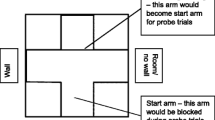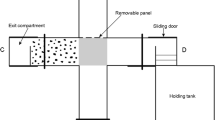Abstract
Place learning is thought to be an adaptive and flexible facet of navigation. Due to the flexibility of this learning, it is thought to be more complex than the simpler strategies such as learning a particular route or navigating through the use of cues. Place learning is crucial in a familiar environment as it allows an individual to successfully navigate to the same endpoint, regardless of where in the environment the journey begins. Much of the research to date focusing on different strategies employed for navigation has used human subjects or other mammals such as rodents. In this series of experiments, the spatial memory of four different species of fish (goldfish, killifish, zebrafish and Siamese fighting fish) was analysed using a plus maze set-up. Results suggest that three of the species showed a significant preference for the adoption of a place strategy during this task, whereas zebrafish showed no significant preference. Furthermore, zebrafish took significantly longer to learn the task than the other species. Finally, results suggest that zebrafish took the least amount of time (seconds) to complete trials both during training and probe.






Similar content being viewed by others
References
Andrews C (2002) An interpet guide to fancy goldfish. Interpret Publishing, Surrey
Bennett AT (1996) Do animals have cognitive maps? J Exp Biol 199:219–224
Braithwaite VA, De Perera TB (2006) Short-range orientation in fish: how fish map space. Mar Freshw Behav Physiol 39(1):37–47
Broglio C, Rodriguez F, Salas C (2003) Spatial cognition and its neural basis in teleost fishes. Fish Fish 4:247–255
Broglio C et al (2010) Selective involvement of the goldfish lateral pallium in spatial memory. Behav Brain Res 210(2):191–201
Brown C (2014) Fish intelligence, sentience and ethics. Anim Cogn 18:1–17
Butail S, Bartolini T, Porfiri M (2013) Collective response of zebrafish shoals to a free-swimming robotic fish. PLoS ONE 8(10):e76123
Carr JA (2002) Stress, neuropeptides, and feeding behavior: a comparative perspective. Integr Comp Biol 42(3):582–590
Casebolt D, Speare D, Horney B (1998) Care and use of fish as laboratory animals: current state of knowledge. Lab Anim Sci 48(2):124–135
Cheeseman JF et al (2014) Way-finding in displaced clock-shifted bees proves bees use a cognitive map. Proc Natl Acad Sci USA 111(24):8949–8954
Cheng K (1986) A purely geometric module in the rat’s spatial representation. Cognition 23:149–178
Clayton NS, Krebs JR (1995) Memory in food-storing birds: from behaviour to brain. Curr Opin Neurobiol 5(2):149–154
Couzin ID et al (2005) Effective leadership and decision-making in animal groups on the move. Nature 433(7025):513–516
Dittman AH, Quinn TP (1996) Homing in pacific salmon: mechanisms and ecological basis. J Exp Biol 199:83–91
Engeszer RE, Ryan MJ, Parichy DM (2004) Learned social preference in zebrafish. Curr Biol 14(10):881–884
Genade T et al (2005) Annual fishes of the genus Nothobranchius as a model system for aging research. Aging Cell 4(5):223–233
Gordon M, Axelrod H (1968) Siamese fighting fish. TFH Publications Inc, New Jersey
Guidelines for the Use of Animals (2012) Guidelines for the treatment of animals in behavioural research and teaching. Anim Behav 83:301–309
Hamilton DA et al (2009) Control of rodent and human spatial navigation by room and apparatus cues. Behav Process 81(2):154–169
Herrera M, Jagadeeswaran P (2004) Annual fish as a genetic model for aging. J Gerontol A Biol Sci Med Sci 59(2):101–107
Iaria G et al (2009) Age differences in the formation and use of cognitive maps. Behav Brain Res 196(2):187–191
Karnik I, Gerlai R (2012) Can zebrafish learn spatial tasks? An empirical analysis of place and single CS-US associative learning. Behav Brain Res 233(2):415–421
Kishi S (2004) Functional aging and gradual senescence in zebrafish. Ann NY Acad Sci 1019:521–526
Lamb EA, Echevarria DJ, Jouandot DJ (2012) The utility of the T-maze in assessing learning, memory, and models of neurological disorders in the zebrafish. Behaviour 149(10–12):1081–1097
López JC et al (2000) Dissociation of place and cue learning by telencephalic ablation in goldfish. Behav Neurosci 114(4):687–699
Magnhagen C (2012) Personalities in a crowd: what shapes the behaviour of Eurasian perch and other shoaling fishes? Curr Zoo 58(1):35–44
Maguire E et al (2000) Navigation-related structural change in the hippocampi of taxi drivers. PNAS 97(8):4398–4403
Miklosi A, Andrew R (2006) The zebrafish as a model for behavioral studies. Zebrafish 3(2):227–234
Miklósi A, Andrew RJ (1999) Right eye use associated with decision to bite in zebrafish. Behav Brain Res 105(2):199–205
Miller N, Gerlai R (2012a) From schooling to shoaling: patterns of collective motion in zebrafish (Danio rerio). PLoS ONE 7(11):e48865
Miller N, Gerlai R (2012b) Automated tracking of zebrafish shoals and the analysis of shoaling behaviour. In: Kalueff AV, Steward AM (eds) Zebrafish protocols for neurobehavioral research. Humana Press, New Jersey, pp 217–230
O’Keefe J, Nadel L (1978) The hippocampus as a cognitive map. Clarendon Press, Oxford
Odling-Smee L, Braithwaite VA (2003) The influence of habitat stability on landmark use during spatial learning in the three-spined stickleback. Anim Behav 65(4):701–707
Packard MG, McGaugh JL (1996) Inactivation of hippocampus or caudate nucleus with lidocaine differentially affects expression of place and response learning. Neurobiol Learn Mem 65(1):65–72
Pike TW et al (2010) Learning by proportional observation in a species of fish. Behav Ecol 21(3):570–575
Portavella M, Vargas J (2005) Emotional and spatial learning in goldfish is dependent on different telencephalic pallial systems. Eur J Neurosci 21:2800–2806
Pravosudov VV, Roth TC II (2013) Cognitive ecology of food hoarding: the evolution of spatial memory and the Hippocampus. Annu Rev Ecol Evol S 44(1):173–193
Ritchie BF (1947) Studies in spatial learning III: two paths to the same location and two paths to two different locations. J Expl Psychol 37(1):25–38
Rodriguez F et al (1994) Performance of goldfish trained in allocentric and egocentric maze procedures suggests the presence of a cognitive mapping system in fishes. Anim Learn Behav 22(4):409–420
Roitblat H, Tham W, Golub L (1982) Performance of Betta splendens in a radial arm maze. Anim Learn Behav 10(1):108–114
Saito K, Watanabe S (2005) Experimental analysis of spatial learning in goldfish. Psychol Rec 55:647–662
Saito K, Watanabe S (2006) Deficits in acquisition of spatial learning after dorsomedial telencephalon lesions in goldfish. Behav Brain Res 172(2):187–194
Salas C et al (1996) Spatial learning and memory deficits after telencephalic ablation in goldfish trained in place and turn maze procedures. Behav Neurosci 110(5):965–980
Shapiro MS, Jensen AL (2009) Parameters of rewards on choice behavior in Siamese fighting fish (Betta splendens). Behav Process 82(1):30–38
Shelton AL, McNamara TP (2001) Systems of spatial reference in human memory. Cogn Psychol 43(4):274–310
Shettleworth SJ, Westwood RP (2002) Divided attention, memory, and spatial discrimination in food-storing and nonstoring birds, black-capped chickadees (Poecile atricapilla) and dark-eyed Juncos (Junco hyemalis). J Exp Psychol Anim B 28(3):227–241
Sih A, Bell A, Johnson JC (2004) Behavioral syndromes: an ecological and evolutionary overview. Trends Ecol Evol 19(7):372–378
Sison M, Gerlai R (2010) Associative learning in zebrafish (Danio rerio) in the plus maze. Behav Brain Res 207(1):99–104
Spence R, Magurran AE, Smith C (2011) Spatial cognition in zebrafish: the role of strain and rearing environment. Anim Cogn 14(4):607–612
Thomas POR et al (2008) Does defection during predator inspection affect social structure in wild shoals of guppies? Anim Behav 75(1):43–53
Tolman EC (1948) Cognitive maps in rats and men (1). Psychol Rev 55(4):189–208
Tolman E, Ritchie B, Kalish D (1946) Studies in spatial learning. II. Place learning versus response learning. J Exp Psychol 36(3):221–229
Tropepe V, Sive HL (2003) Can zebrafish be used as a model to study the neurodevelopmental causes of autism? Genes Brain Behav 2:268–281
Van Gerven DJH et al (2012) Direct measurement of spontaneous strategy selection in a virtual Morris water maze shows females choose an allocentric strategy at least as often as males do. Behav Neurosci 126(3):465–478
White GE, Brown C (2014) A comparison of spatial learning and memory capabilities in intertidal gobies. Behav Ecol Sociobiol 68(9):1393–1401
Williams FE, White D, Messer WS (2002) A simple spatial alternation task for assessing memory function in zebrafish. Behav Process 58(3):125–132
Wolbers T, Hegarty M (2010) What determines our navigational abilities? Trends Cogn Sci 14(3):138–146
Wright D, Krause J (2006) Repeated measures of shoaling tendency in zebrafish (Danio rerio) and other small teleost fishes. Nat Protoc 1(4):1828–1831
Acknowledgments
The authors would like to acknowledge the following individuals for assistance with laboratory set-up and fish husbandry: Georgina Glaser, Sinéad Smith, Chris Preshaw, Gillian Riddell and other members of the technical staff at the School of Biological Sciences, QUB. We would also like to thank the funding bodies of this research: The Department of Employment and Learning, Northern Ireland and Queen’s University Belfast. Finally, we would like to thank Ken Cheng and Hannah White for advice on statistics.
Author information
Authors and Affiliations
Corresponding author
Ethics declarations
Conflict of interest
The authors declare that they have no conflict of interest.
Rights and permissions
About this article
Cite this article
McAroe, C.L., Craig, C.M. & Holland, R.A. Place versus response learning in fish: a comparison between species. Anim Cogn 19, 153–161 (2016). https://doi.org/10.1007/s10071-015-0922-9
Received:
Revised:
Accepted:
Published:
Issue Date:
DOI: https://doi.org/10.1007/s10071-015-0922-9




